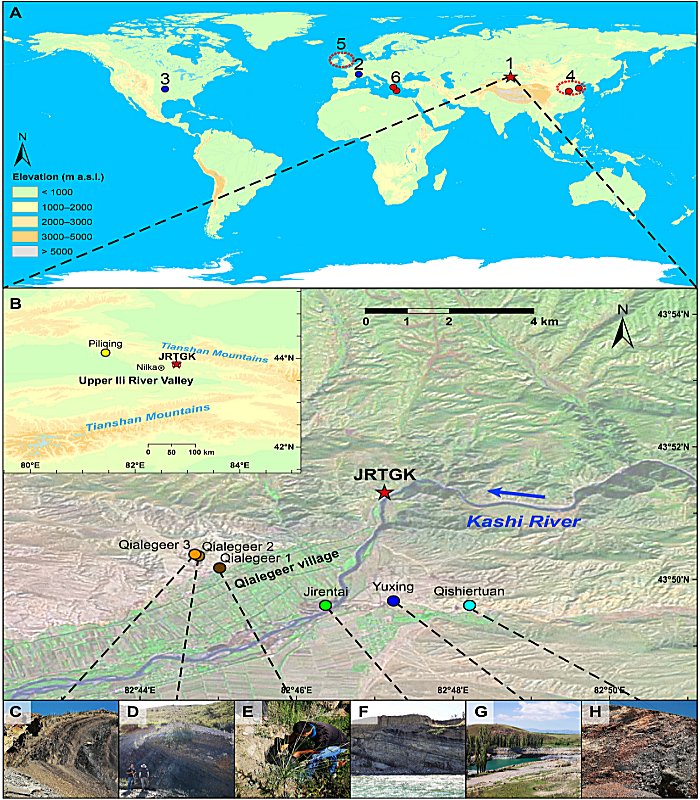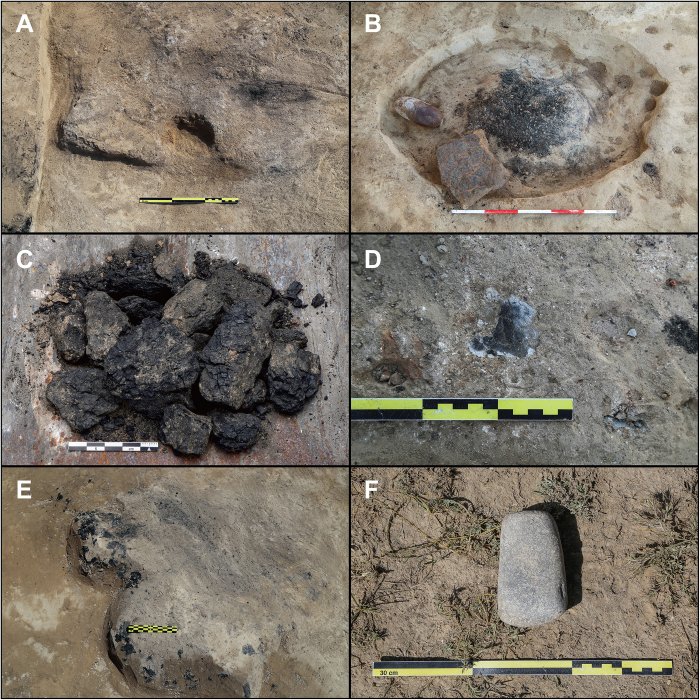Conny Waters – AncientPages.com – Coal has long played a crucial role in the life of human civilizations. Records of systematic coal fuel exploitation date back to the late third millennium B. P., and there is no evidence the systematic exploitation of coal for fuel before 2500 B.P.

Fig. 1. Geographic setting of the archaeological sites and the coal outcrops mentioned in this study.
(A) Places known for the early utilization of coal fuel: (1) JRTGK (this study), (2) two Paleolithic sites in southern France (14, 15), (3) Lewisville Paleolithic site in North America (13), (4) sites with reported use of coal for fuel in central China (16, 20), (5) Roman Britain (19), and (6) two Late Bronze Age sites with evidence of lignite combustion in eastern Mediterranean (17). (B) Geographic setting of JRTGK and the relevant coal outcrops. (C to H) Images of the coal outcrops near the site, with dashed lines indicating their positions.
Making fire was vital for early humans to better adapt to the living environment. Later, wood, charcoal, and dung were widely used as fuels.
Although coal has been used for making ornaments since the Late Paleolithic in Europe and the Neolithic in northern China, the behavior of systematic exploitation of coal for fuel occurred much later. Evidence of sporadic lignite (weakly coalified coal) combustion for fuel has been found at several Late Paleolithic sites in Europe and North America. However, none of these sites has contributed evidence of how the local groups exploited the coal.
On the basis of archaeological and textual evidence, the earliest reliable record of the systematic exploitation of coal for fuel is from the Chinese Han Dynasty (2152 to 1730 B.P., although people in the Warring States Period (2426 to 2171 B.P.) of China and Classical Greece (2460 to 2273 B.P.) seem to have mastered the knowledge of coal for fuel.
In Europe, people in Roman Britain started to burn coal for fuel in the Common Era. Some scholars ᴀsserted that coal was used in some locations during the Bronze Age of northern China (~4000 to 3000 B.P.) nevertheless, a more detailed archaeological context and reliable chronology are required for further verification.
Although recent research on biomarkers has revealed lignite combustion since approximately 3400 B.P. in the eastern Mediterranean, however, direct archaeological evidence for using coal as fuel is absent. Despite wide research, no direct evidence of systematic coal fuel exploitation during prehistory was found until the archaeological excavation of the Jirentaigoukou site.
This research focuses on the earliest systematic exploitation of coal for fuel at the Jirentaigoukou site in Xinjiang, northwestern China, at ~3600 B.P. Large coal remains have been unearthed at this site, also known as Jartai Pᴀss or Goukou). It was a large Bronze Age settlement in the Upper Ili River Valley located in China‘s central Tianshan Mountains. It gave researchers a unique opportunity to explore when, why, and how the people of the area adopted coal as their major source of fuel.
Researchers combined archaeological evidence and paleoenvironmental records to obtain a local history of the earliest systematic coal exploitation for fuel.
Charcoals, human bones, and animal bones at the site were sampled for radiocarbon dating.

Fig. 2. Typical archaeological remains related to coal exploitation at JRTGK.
(A) Coal ash unearthed from the floor of house site F1. (B) Coal pile unearthed from pit H112 in house site F25. (C) Coal lumps unearthed from house site F3. (D) Coal fragments incompletely burnt in stratum T2L3a. (E) Coal storage location near a furnace. (F) Stone artifact unearthed near a coal pile that was highly likely used for the coal fuel process.
Only a small number of archaeological remains unearthed from JRTGK, including one burial and three charcoal kilns, were dated to the earlier period (~4500 to 4300 B.P.). It means these kilns are considered the earliest yet known and the sole residential remains of the Chalcolithic Age in Xinjiang.
“A large number of coal remains were unearthed from the cultural layers of this period, providing key evidence to study the technologies related to storage, processing, and usage. Local excavation also revealed coal lumps piled in storage pits and houses, crushed by stone artifacts, and burnt as fuel in the hearths and smelting locations, as well as for making pottery molds…” the research paper states.
The recent research shows that human behavior of systematic exploitation of coal as fuel to is now extended to c. 3600 B.P. approximately a millennium earlier than previous estimation.
No archaeological evidence of coal fuel exploitation has yet been found within the neighboring regions post-2900 B.P. but more future studies are needed to better understand the pattern of early use of coal for fuel.
Read more in the paper
Written by Conny Waters – AncientPages.com Staff Writer





